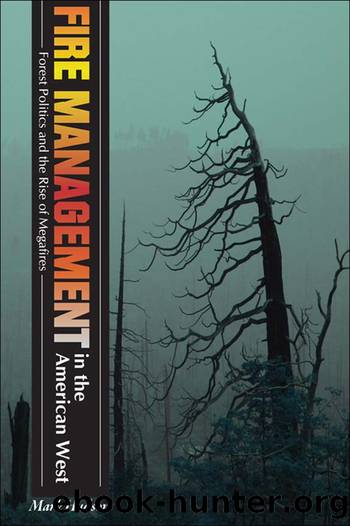Fire Management in the American West by Mark Hudson

Author:Mark Hudson
Language: eng
Format: epub
Publisher: University Press of Colorado
Published: 2011-08-14T16:00:00+00:00
CHAPTER FIVE
OUT OF THE FRYING PAN
Catastrophic Fire as a “Crisis of Crisis Management”
The development of civilization and industry in general has always shown itself so active in the destruction of forests that everything that has been done for their conservation and production is completely insignificant in comparison.
Karl Marx, Capital, vol. 2 (New York: Vintage, 1979), 322
The thirty-three-year struggle for federal regulation, which began in 1919 with Forest Service employees and allied conservationists working through the Society of American Foresters (SAF) under Gifford Pinchot’s leadership, ended in defeat. The USFS leadership’s role had swung from one side of the issue to the other, eventually letting the struggle drop. Pinchot, Henry Graves, and William Greeley—in particular the latter—had been pivotal in entrenching the principle of cooperation, through which they hoped to induce private owners to adopt practices of sound forestry as they understood it. Pinchot was the first to abandon this hope, and he did so with a conviction that saw him butt heads time and time again with the organization he had helped launch. Greeley, on the other hand, remained convinced about the promise of free-enterprise forestry throughout his career, growing more anti-regulation as he moved from the Forest Service to the West Coast Lumbermen’s Association to the American Forest Products Industries (AFPI). With Ferdinand Silcox’s ascent to its helm, the USFS swung decisively toward a belief that the end of forest devastation required strong federal action—including police action—and the subordination of individual private gain to social benefit. Earle Clapp and Lyle Watts carried that torch until the early 1950s.
Throughout all this, the Forest Service’s essential mission remained constant: perpetuation of nature’s contribution to capitalist production in the form of timber. The agency’s relations with the timber industry and its proposed means of accomplishing its mission fluctuated from cozy and cooperative to antagonistic and regulatory with the leadership. Regardless of the character of the relationship and the proposed management strategy of various Forest Service administrations, however, the cooperative principle encoded in Clarke-McNary remained the law. Thirty-three years of effort to install some form of (generally weak and highly qualified) federal regulation of forestry broke constantly against the walls of organized timber capital. Each time it did so, those charged with managing the nation’s forests fell back on the established ground of “cooperation.” The latter, although it encompassed research and replanting to some extent, boiled down largely to an agreement by the federal government to assist in putting out fires nationwide and to induce the states to help with that effort. In return, federal foresters continually hoped for improved private forestry as the obstacle of risk on investment (and thus pressure to liquidate “assets” in the form of forests) was reduced. Contrary to the industry’s relentless public relations efforts, which never stopped claiming that private forestry was steaming forward toward sustainable forestry and would accelerate once the risk of fire was subdued, every assessment the Forest Service carried out showed that its hopes were in vain, thus renewing and strengthening its conviction that federal regulation was needed.
Download
This site does not store any files on its server. We only index and link to content provided by other sites. Please contact the content providers to delete copyright contents if any and email us, we'll remove relevant links or contents immediately.
The Secret History by Donna Tartt(16622)
The Social Justice Warrior Handbook by Lisa De Pasquale(11489)
Thirteen Reasons Why by Jay Asher(7788)
This Is How You Lose Her by Junot Diaz(5770)
Weapons of Math Destruction by Cathy O'Neil(5036)
Zero to One by Peter Thiel(4824)
The Myth of the Strong Leader by Archie Brown(4789)
Promise Me, Dad by Joe Biden(4447)
Beartown by Fredrik Backman(4415)
Stone's Rules by Roger Stone(4415)
How Democracies Die by Steven Levitsky & Daniel Ziblatt(4398)
The Fire Next Time by James Baldwin(4342)
100 Deadly Skills by Clint Emerson(4076)
A Higher Loyalty: Truth, Lies, and Leadership by James Comey(4032)
Rise and Kill First by Ronen Bergman(4012)
The David Icke Guide to the Global Conspiracy (and how to end it) by David Icke(3881)
The Farm by Tom Rob Smith(3872)
Secrecy World by Jake Bernstein(3782)
The Doomsday Machine by Daniel Ellsberg(3730)
